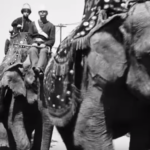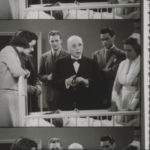Robert Altman’s Compelling Early Cornball, Preserved
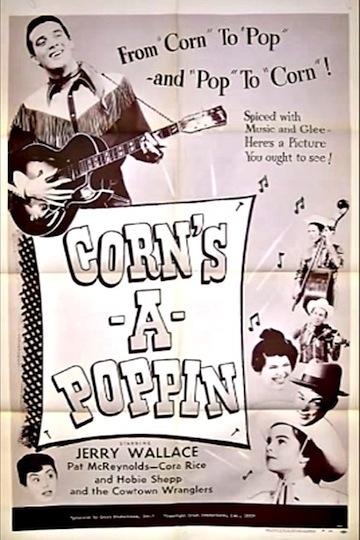 Writing last year about the curious Corn’s-A-Poppin’, which is about a plot to bring down an oddly corn-themed television variety show, Marilyn Ferdinand mused on why Robert Altman, who helped at the age of 29 to write the 1955 feature, early in his career, later disowned it.
Writing last year about the curious Corn’s-A-Poppin’, which is about a plot to bring down an oddly corn-themed television variety show, Marilyn Ferdinand mused on why Robert Altman, who helped at the age of 29 to write the 1955 feature, early in his career, later disowned it.
The restoration of the film, which the Northwest Chicago Film Society prepared with a 2013 grant from the National Film Preservation Foundation, is in distribution, and should certainly interest the Altman completist – get your local film society to book it, today!
Perhaps, Ferdinand said, Corn’s-A-Poppin’ was like many a product of artists who “disavow and try to bury their juvenilia.” She said: “Often, such works are half-baked and embarrassing,” or are far below their later, more representative work.
Corn’s-A-Poppin’ certainly is that. It’s from the first phase of Altman’s career, which largely took place in his home town of Kansas City, before he settled in Hollywood, although even during his Kansas City days he did go there with scripts that didn’t have much success beyond a B movie or two.
That’s what led himto return home to make industrial as well as educational films for the Calvin Company, a large producer of educational and industrial films. Altman occasionally directed the films, but is credited only with co-writing Corn’s-A-Poppin’. It is a country-western musical, and was, says Ferdinand, “intended to be more affordable for Midwestern exhibitors to screen than the high-priced Technicolor epics Hollywood was bankrolling at the time, to compete with television.”
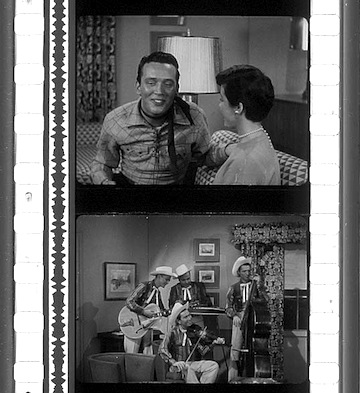 The plot revolves around a TV hour produced by a huckster, Waldo Crummet, who has foisted on the show’s boss, TJ, his latest love conquest, a singer as skilless as she is loud. The emcee of the show, designed to tout Pinwhistle brand popcorn, is a country rube, Johnny, played by then-tyro country-pop singer Jerry Wallace. Johnny’s prickly relationship with Sheila, TJ’s gal friday, could turn to romance if only he wasn’t under the unlikely delusion that she is involved with the boss, who looks about thrice her age.
The plot revolves around a TV hour produced by a huckster, Waldo Crummet, who has foisted on the show’s boss, TJ, his latest love conquest, a singer as skilless as she is loud. The emcee of the show, designed to tout Pinwhistle brand popcorn, is a country rube, Johnny, played by then-tyro country-pop singer Jerry Wallace. Johnny’s prickly relationship with Sheila, TJ’s gal friday, could turn to romance if only he wasn’t under the unlikely delusion that she is involved with the boss, who looks about thrice her age.
Crummet, the huckster producer, turns out to have brought his belle onto the show in an effort to scuttle it, and the show, which is saved only by the talents of Johnny and his band of country songsters. They are encouraged by Johnny’s sassy little sister, Suzie, played scene-stealingly by Little Cora Rice in her only screen role, more’s the pity. (A performer from an early age, from a family of performers, she and her siblings had a radio hour from which she was the break-out star, leading to some local television appearances and many similar performances; she went to Hollywood with her mother to attend a talent school for kids, but her career did not proceed far beyond that; she is still alive and well.)
Corn’s-A-Poppin’ is an “orphan film,” which is to say, a work that is not protected by copyright, or for which no one has a financial incentive to preserve or restore existing copies or negatives. “There is a copyright notice on the film, but copyright papers were never filed with the copyright office,” says Kyle Westphal, a co-founder and programmer at Northwest Chicago Film Society. “That means that from the moment it screened in 1955, it was basically a public-domain work, and not as asset to anybody, in the asset-protection sense.”
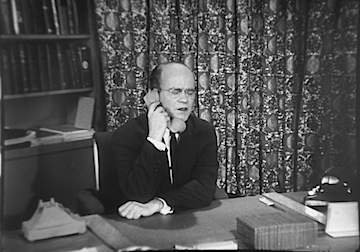 It was also a “regional film,” in the sense that it was intended for release within the geographic range of its production, Kansas City. “We don’t know what lab originally processed the negative or made the release prints,” says Westphal. It was likely in Kansas City, home to the Calvin company, for which Altman and director Robert Woodburn worked. Thanks to its various industrial filmmakers, the city had a number of small, regional labs. Those, says Westphal, “of course have pretty much all closed down.” So, it’s a fair assumption that the film’s original elements will never be located. He says: “I guess you should never make the default assumption that negatives are lost,” but in this case, “whenever this mystery lab shut down, I don’t think there would have been any repository or certainly any major film archive that would have been there to save the material from the garbage dump.”
It was also a “regional film,” in the sense that it was intended for release within the geographic range of its production, Kansas City. “We don’t know what lab originally processed the negative or made the release prints,” says Westphal. It was likely in Kansas City, home to the Calvin company, for which Altman and director Robert Woodburn worked. Thanks to its various industrial filmmakers, the city had a number of small, regional labs. Those, says Westphal, “of course have pretty much all closed down.” So, it’s a fair assumption that the film’s original elements will never be located. He says: “I guess you should never make the default assumption that negatives are lost,” but in this case, “whenever this mystery lab shut down, I don’t think there would have been any repository or certainly any major film archive that would have been there to save the material from the garbage dump.”
Westphal’s interest in the film began in 2007, whilst he was a film programmer. He told his friends it was “extraordinary and unaccountable,” and organized with some of them to borrow a print from the Wisconsin Center for Film and Theater Research, to show at Doc Films, a University of Chicago student-operated film society.

Kyle Westphal, Northwest Chicago Film Society
From there his interest grew; he arranged another presentation. “At that time,” he says, “It was easy enough to think perhaps naively that my job was to champion this film, to promote a film in which I had no stake, and to change critical conversation about it.
“I wasn’t yet thinking in archival terms.”
He was still getting blank stares from people he mentioned it to, other than from fellow Altman aficionados who had read Patrick McGilligan’s Robert Altman: Jumping Off the Cliff. There, McGilligan memorably characterized the film as “slumberous, hammy, amateurish and clichéd, ultra-boring. Folks who rate Quintet the nadir of Altman’s career have not seen Corn’s-A-Poppin’.”
Juvenilia should surely get some sort of partial pass for being atrocious. But McGilligan notes that Altman sought to dodge even that dispensation: he “does not own up to much of his career before M*A*S*H,” and in fact “he has said that everything he did before he began to direct motion pictures in earnest is ‘garbage.’” Corn’s-A-Poppin’, writes McGilligan, surely piling on a bit, was “one of the worst movies ever made.”
Altman was in an extended apprenticeship – it would be 16 years until McCabe and Mrs. Miller and 25 until the triumph of Nashville. Before the director moved from Kansas City to California in 1956, says McGilligan, “he was as busy as he ever was in Hollywood, full of crackpot schemes and whirling-dervish energy, churning out an amazing amount of film independent of his Calvin work. A full account of what he did, exclusive of Calvin, would no doubt astonish even Altman.”
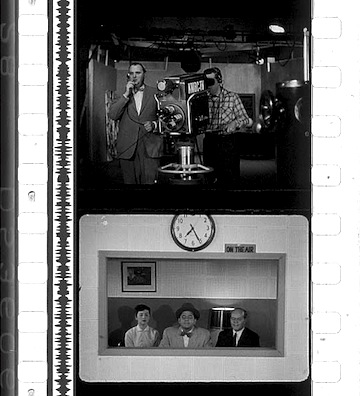 McGilligan devotes a chapter to these Kansas City years, including a couple of pages to Corn’s-A-Poppin’, and the trajectory they put Altman on. Part of the interest of the period is that some of his many television series and pilots, local commercials, and early features foreshadowed his later themes. That is true of Corn’s-A-Poppin’ – the comically shifty Crummet, for example, would blossom fully into the tawdry studio executives of 1992’s The Player.
McGilligan devotes a chapter to these Kansas City years, including a couple of pages to Corn’s-A-Poppin’, and the trajectory they put Altman on. Part of the interest of the period is that some of his many television series and pilots, local commercials, and early features foreshadowed his later themes. That is true of Corn’s-A-Poppin’ – the comically shifty Crummet, for example, would blossom fully into the tawdry studio executives of 1992’s The Player.
As Westphal pondered all this, he says, he realized that no archive was taking any steps to preserve whatever Corn’s-A-Poppin’ prints or other material might exist; so, “it slowly dawned on me that instead of it being a case where it was my job to see the film and talk it up and get other people to see it, it might actually be my responsibility to see that something happens to it, to protect it.”
He and two fellow projectionist-programmers, Becca Hall and Julian Antos, had formed the Northwest Chicago Film Society in early 2011, originally as a film series and occasional publisher, “but preservation was something that we thought was in the distant future for us, if at all,” he says. Still, “we knew that maybe we could do something, some day, to preserve this film.”
When a print appeared for sale on eBay, “we thought that maybe this was our only chance,” he says. “So the film society bought that print.” When it arrived, he says, “we were excited to discover it still had the reel bands on it” — those are the thin cardboard strips placed around reels to ensure that film doesn’t spool out during transportation. “There was a lot of writing on the reel band that documented every time the film had shown,” he says. And it had barely been played in 50 years, so was in good condition. “It’s not an original camera negative, and not a fine-grain print, but it is original to the film’s release,” so that made it a good candidate for a preservation project.”
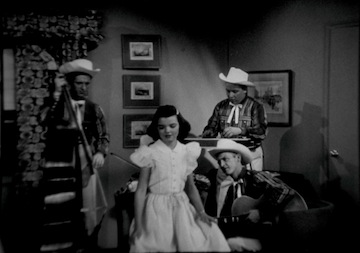 He explains: “We suspect that because it was such a small film and because it would have had such a small print run, initially, the film prints we had would had been struck off the camera negative because I doubt that they would have struck a fine-grain print and then making a dupe neg, just to make 10 prints.”
He explains: “We suspect that because it was such a small film and because it would have had such a small print run, initially, the film prints we had would had been struck off the camera negative because I doubt that they would have struck a fine-grain print and then making a dupe neg, just to make 10 prints.”
Neither the eBay nor Wisconsin print was complete nor in perfect condition, but “if we put them together we could make a complete print [a new duplicate negative, on polyester film stock, with a re-recorded soundtrack negative], without any splices, without any jumps” and – per usual best preservation practice – without altering the original prints, at all.
“We made an answer print, and made a bit of a contrast correction on that, which is totally normal, especially when you’re working with older material.” That allows the Society to make prints, and send them out. The debut of the restoration was at a UCLA Film and Television Archive retrospective of Altman’s work, in May 2014.
“They paired the film with some Calvin shorts, with some of the same actors, so you could see the evolution of Altman’s technique, and you could see more connection than you might expect between films that were basically shilling for a tire company or a tractor company, and the film which is essentially a narrative feature, for everybody. That was a great context in which to see the film.”
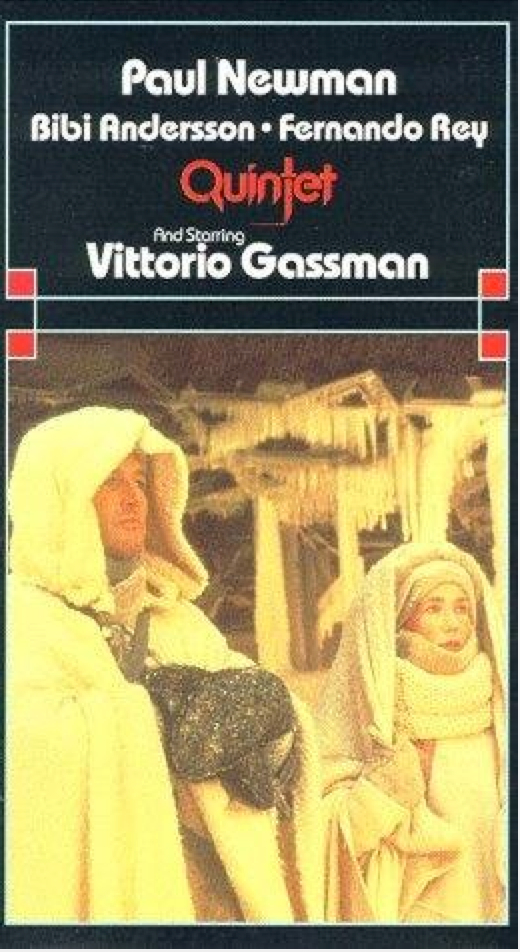
Worse than “Quintet”?
The project has been a great success, and the timing of it fell into place nicely, says Westphal: “We did feel a sense of urgency about it. The print was in our storage space, which is climate controlled, so it wasn’t a sense that it would be endangered, in the near future, but with labs closing down at the rate they were, we really felt it would be a shame if this went on the back burner and then by the time we wanted to pursue it, maybe the quality of lab work we would need to restore the film simply wouldn’t be available to us.”
“As an organization that is dedicated to preserving not just the films themselves but the experience of seeing film in a theater on a 35mm print, we were thinking, ‘Look, it’s not going to be a tremendous contribution monetarily, in the scheme of things, for us to preserve this film, so we should put our money where our mouth is, and we should find a way to support labs who are doing this heroic work, directly.’”
So they applied for a grant from the National Film Preservation Foundation, which has always been helpful to small organizations, whether specialist film archives, or not. And won a restoration grant. Says Westphal: “The NFPF is a group that has to tremendous effect refocused the conversation on orphan films and orphan media. Twenty-five years ago if you wanted to talk about archiving and preservation, people would have been talking about Hollywood narrative films. But by and large there are usually corporate entities that have incentives to look after that material. There are studios that profit from preserving their libraries, because that means they can later release the films on DVDs, or Blu-rays, or streaming, and get a lot of ancillary revenue on doing due diligence on their libraries.”
The NFPF has smiled, fortunately, on other areas of films, to say, “if you have, say, a home movie, or if you have an industrial film that is produced to promote a local business, that is also part of film history.”
The significance of the grant goes beyond preserving the film, says Westphal. It also has preserved insights into the film culture of Kansas City. It had ancillary film services that were concentrated in a district called Film Row. That was a center for print exchanges for film studios: a hub from which studios distributed their product, as existed in many metropolitan areas. Theater owners would go there to see what was available. “While you were there you could also do things like buy your popcorn machine,” says Westphal. That was the market Corn’s-A-Poppin’ was pitched to.
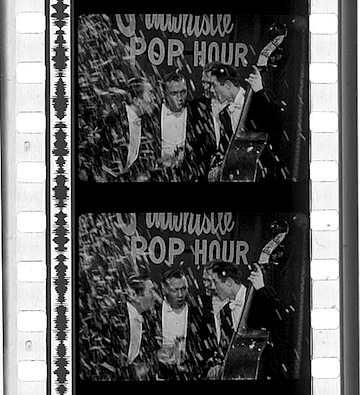 Turns out Kansas City was crucial to the arguably extremely annoying American practice of munching loudly on popcorn while watching movies, regardless of films’ seriousness. It was, explains Westphal, the home of the electric popper, and “the origin of the small-scale industrial tycoons who made popcorn part of our movie-going experience. So you look at this, and say, ‘This is a silly film…’ I love the film but I’m not going to say it’s not a silly film. ‘This is a silly film, but the more layers you peel back, it also is a document. It is a document of local history and a document of peoples’ livelihoods.’”
Turns out Kansas City was crucial to the arguably extremely annoying American practice of munching loudly on popcorn while watching movies, regardless of films’ seriousness. It was, explains Westphal, the home of the electric popper, and “the origin of the small-scale industrial tycoons who made popcorn part of our movie-going experience. So you look at this, and say, ‘This is a silly film…’ I love the film but I’m not going to say it’s not a silly film. ‘This is a silly film, but the more layers you peel back, it also is a document. It is a document of local history and a document of peoples’ livelihoods.’”
“In this one feature,” he says, “you really have in a window into a whole other world of film making.”
THE FILM BEGINS quite promisingly, with some comic exchanges marked with Altman wit.
Sheila, the gal friday, snips at Johnny when he becomes petulant about his limited air time: “Maybe you should stick to announcing the show, and let Waldo run it.” Johnny: “Yeah, maybe I ought to.”
…and then when he leaves, she reiterates her obvious interest in him: “Well, what’s a girl supposed to do, anyway, use a butterfly net?”
The crooked impresario Waldo Crummet, trying to foist an unlikely starlet on the producer, TJ, who is skeptical but a pushover: “Can she sing? Can she sing? Can Pinwhistle popcorn pop? This girl is a livin’, breathin’ nightingale.”
Johnny Wilson’s sassy kid sister, Suzie (Little Cora Rice): “And by the way, the show stinks.”
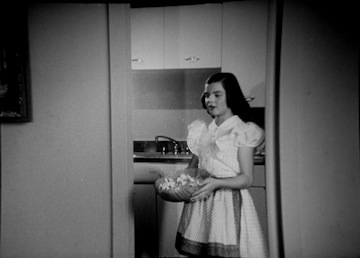 Sheila: “Oh, Johnny, that was…” Suzie: “Corn, pure, unpoppable corn.”
Sheila: “Oh, Johnny, that was…” Suzie: “Corn, pure, unpoppable corn.”
Waldo’s starlet, aggrieved that the schmuck won’t kiss her: “Not one eentsy-weentsy kiss?” Waldo: “You gotta think of your voice. Kissin’s the worst thing in the world for a singer; you’re liable to get vocalcorditis.” She: “What’s that.” Waldo: “That’s kind of a first cousin to corn rust, or wheat blight, only it’s much worse.”
From there the film doesn’t really sustain forward motion, although it remains charming enough.
There’s an atrocious copy dubbed from television and posted online, but you really will want to see Northwest Chicago Film Society’s restoration, as audiences at several film groups now have. The Society is dedicated to screening 35mm film, in a theater. And to renting its holdings out to any group equipped to present it that way.
For more about Corn’s-A-Poppin’, see Kyle Westphal’s entry on the Northwest Chicago Film Society blog.
Previous Post: Owen Land's Strange, Expansive Film World
Next Post: 25 Films Added to US National Film Registry



